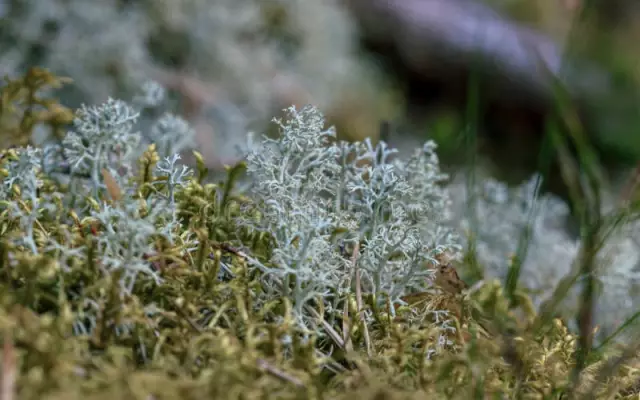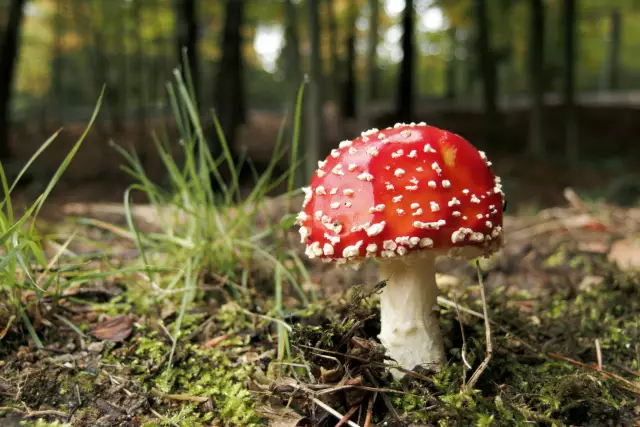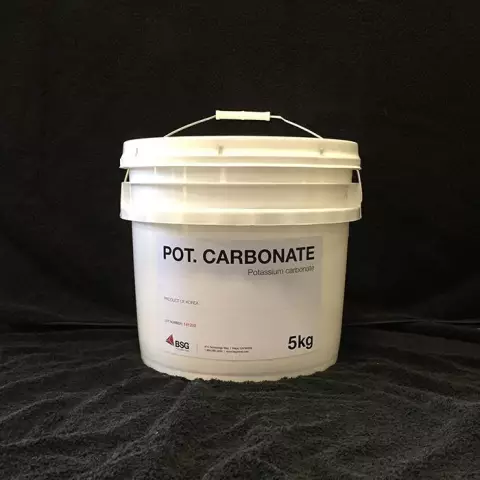- Author Rachel Wainwright [email protected].
- Public 2023-12-15 07:39.
- Last modified 2025-11-02 20:14.
Icelandic cetraria
Instructions for use:
- 1. Description
- 2. Distribution
- 3. Collection and procurement of medicinal raw materials
- 4. Chemical composition
- 5. Application in traditional medicine
- 6. Application in official medicine
- 7. Contraindications to use
Cetraria Icelandic or Icelandic moss is a perennial lichen belonging to the Parmeliad family.
Description

The plant is a symbiosis of two microorganisms - algae and fungi. Both microorganisms are so closely related to each other that they represent a single integral organism.
Cetraria moss outwardly is erect bushes with irregularly ribbon-like blades, narrow, leathery-cartilaginous, reaching 0.3-0.5 cm in width and 10 cm in height, greenish-brown in color, with short dark cilia. The edges of the blades are slightly curved towards the top.
Sometimes apothecia, or fruiting bodies, plate-shaped with a slightly serrated edge, brownish tint develop at the ends of the lobes. In apothecia, bags with spores develop. Spores are colorless, unicellular, epileptic, 8 spores in each bag.
Distribution of the Icelandic cetraria
Cetraria moss is widespread in Australia, America, Asia and Europe. Occurs in Central and Northern Europe, in the forest zone and tundra of Siberia, in the Ukraine - in the Carpathians. In Europe, it grows in the Alps, Pyrenees and Balkans. In the northern part of Russia, it is more common in the European part. Grows in the mountains of the Far East, Sayan, Altai and Caucasus. Typical of barren open spaces and pine forests. It grows in the tundra, in the highlands (up to an altitude of 1500 m above sea level and above), on grassy and rocky areas, in mountain forests, high-mountain glades.
Cetraria prefers sandy unshaded areas, forming clean thickets. It can be found in heather thickets, where it grows in small groups, and in marshy areas.
Collection and procurement of medicinal raw materials cetraria
For medicinal purposes, dried cetraria thallus is used. It has a bitter-slimy taste and a faint peculiar smell. The thallus is dried in the shade or in the sun, spreading it in a thin layer on a cloth or paper. The procurement of raw materials is carried out mainly in the summer.
Raw materials are stored in tightly closed jars or in boxes with paper lining in a dark, dry, cool place.
Chemical composition
The study of the chemical composition of cetraria began several hundred years ago, and today it has been fairly well studied.
Thallus consists mainly of carbohydrates, among which there is isolichenin, lichenin, umbilicin, mannitol galactomannate, chitin, sucrose, erythritol, hemicellulose and others.
Thallus of Icelandic moss is capable of accumulating up to 80% of polysaccharides, which dissolve when extracted with hot water, forming a thick mass. When hydrolyzed, lichenin produces glucose.
Cetraria moss contains organic acids, which are called lichen. It is the acids that give the plant a bitter taste and determine its antibiotic and tonic properties.
In addition to acids, the thallus contains proteins, gum, wax, fats, ascorbic acid, vitamin B12, pentacyclic triterpene Fridelin, naphthoquinone (juglone), minerals and pigments.
An interesting fact - Cetraria moss contains antiscorbutic vitamin C in an easily digestible form, and it remains in a dried plant for three years.
The use of Icelandic cetraria in folk medicine
There is evidence that the plant was used for medicinal purposes in ancient Egypt, two thousand years BC.
In the Middle Ages, Icelandic cetraria was widely used in folk medicine in the countries of Northern Europe - Sweden, Norway, Iceland. It was used as a coating agent for bronchitis and colds.
In the form of decoctions and infusions in the Scandinavian countries, the plant was used to stimulate appetite, and also as a general tonic, nutritive and emollient.
Icelandic cetraria was widely used in the treatment of pulmonary tuberculosis, laryngitis, whooping cough, bronchial asthma, bronchitis and other bronchopulmonary diseases.
Cetraria moss was used for malignant neoplasms, bleeding, and also as a means capable of suppressing excessive sexual excitability in women.
Outwardly, in the form of lotions, Cetraria was used for ulcers, wounds, burns, abscesses, acne, boils, and microbial eczema.
The use of Icelandic cetraria in official medicine
As a medicinal raw material, the use of Icelandic cetraria began in the 17th century. During the second half of the 18th and the first half of the 19th centuries, the use of cetraria moss in official medicine was very widespread. This plant has been a traditional remedy for pulmonary tuberculosis, and the thallus has been used in many medicines.
The first pharmaceutical preparation based on lichen acids was created in the 50s of the 20th century in Germany and was called Evozin. It had antimicrobial activity due to the presence of usnic and severnic acids in it. He was prescribed to treat lupus erythematosus and other diseases caused by pathogenic microorganisms.
Against pulmonary tuberculosis, German scientists proposed the drug Eosin-2, which, in addition to usnic and severnic acids, contained such lichen acids as caperatic, physodic, atronaric.
For skin diseases and tuberculosis, a mixture of streptomycin and usnic acid has been successfully used.
In Japan, an antibiotic from cetraria has been developed for the treatment of actinomycosis.
In therapeutic practice, Icelandic cetraria also found application, thanks to its expectorant and emollient properties, due to the high content of mucous substances in it. It is used for many bronchopulmonary diseases.
In Finland, a patented method of obtaining a remedy for rhinitis, cough and asthma from cetraria, using dandelion, extracts from yarrow herb, cinquefoil rhizomes, coltsfoot herb, willow bark, bearberry leaves, juniper fruits.
In the USSR, in 1956, a preparation of sodium usninat based on usnic acid was obtained, which was used as an antimicrobial agent in the treatment of cracks, burns and wounds. The drug Balsam Binan was released on the basis of sodium usninat.
Many other drugs are known, which include cetraria:
- Bronchical plus for children (cough syrup);
- Bronchialtee 400 (tea drink used for colds);
- Isla-Mint Pastillen (cough lozenges);
- Salus Bronchial-Tee (tea for inflammation of the respiratory organs);
Contraindications to the use of Icelandic cetraria
The use of Icelandic cetraria and preparations with its content is contraindicated in pregnancy and lactation, with stomach ulcers, as well as with gastritis with high acidity.
Information about the drug is generalized, provided for informational purposes only and does not replace the official instructions. Self-medication is hazardous to health!






